The best free self-guided walk of Manchester:
From cotton mills to glass towers
- Explore Historic Warehouses, Canals and Contemporary Landmarks on Manchester self-guided walk 1
- See into the City’s Industrial Past and Modern Transformation
From the world’s first industrial city to a bold symbol of urban regeneration, Manchester’s architecture tells a compelling story of innovation and transformation. On Manchester self-guided walk 1, you will trace Manchester’s journey from industrial powerhouse to contemporary metropolis, exploring how the city has reimagined its industrial heritage while embracing cutting-edge design.
Starting at the Museum of Science and Industry, housed in the world’s first railway station, we’ll follow the route of historic waterways and railways through Castlefield’s urban heritage park. The tour winds through the city centre, where Victorian cotton wealth built magnificent civic buildings like the Town Hall, now undergoing innovative restoration. We’ll see how industrial spaces have been reinvented – from the Royal Exchange’s transformation into a suspended theatrical pod to the gleaming glass facades of modern Manchester. Each stop reveals how the city has maintained its pioneering spirit, from canal age to digital age.

Manchester self-guided walk 1, Stop 1
Museum of Science and Industry (MOSI)
Entrance fee may be required: See MOSI website

What you will see
Grade I listed 1830 warehouse buildings
World’s first railway station building (Liverpool Road Station)
Working steam engines and industrial machinery
Interactive exhibits showing Manchester’s scientific achievements
Original railway yard and air and space hall

Historical & cultural significance
Located in the heart of the world’s first industrial city Demonstrates Manchester’s pivotal role in the Industrial Revolution Shows the birth of the railway age and cotton industry Houses developments in textile manufacturing that changed global industry Represents the birthplace of the computer age with the Manchester Baby replica

Look out for…
Original cast iron columns and wooden beam construction Historic railway platforms and tracks Victorian sewer systems display Original factory workers’ timekeeper’s office The Power Hall’s collection of working steam engines
To Stop 2, Merchants Bridge: Exit MOSI and cross Liverpool Road into Duke Street. Continue past the reconstruction of Mancunium Roman Fort, under the railway bridge, bending right under the Castlefield Viaduct then turn left into Castle Street. As you emerge from under 2 consecutive railway bridges, you will start to see the Bridgewater Canal and Merchants Bridge on your right.
Manchester self-guided walk 1, Stop 2:
Bridgewater Canal/Merchants Bridge
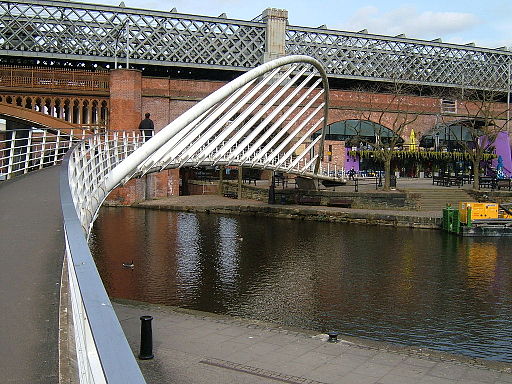

What you will see
World’s first industrial canal (1761)
Modern Merchants Bridge (1996)
Historic canal basins and warehouses
Contemporary waterside developments
Mix of industrial heritage and modern architecture

Historical & cultural significance
First canal that didn’t follow natural water courses
Revolutionized industrial transport and enabled Manchester’s growth
Reduced coal prices by 50% upon opening
Modern bridge represents Manchester’s regeneration
Shows continuous innovation in transportation from 18th to 21st century

Look out for…
Original stone canal walls and engineering Innovative design of Merchants Bridge
Original mooring rings and canal furniture Integration of modern developments with historic infrastructure
Views of how old and new architecture interact along the waterfront
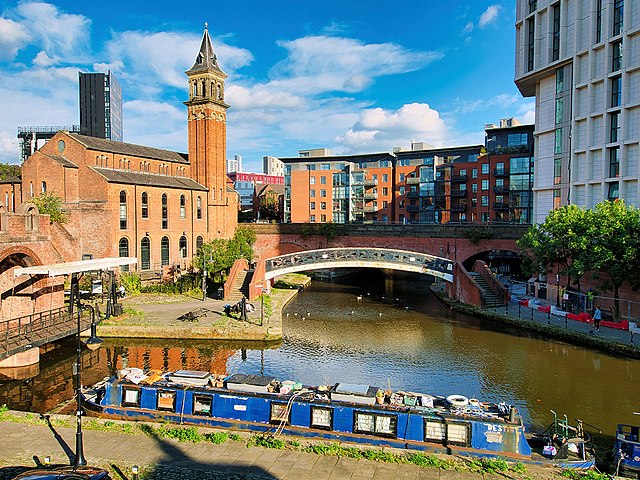
Manchester self-guided walk 1, Stop 3:
Castlefield Historical Zone

What you will see
Network of canals and waterways
Massive Victorian railway viaducts
Converted warehouses now serving as apartments and offices
Historic locks and mooring points
Modern waterfront developments

Historical & cultural significance
Britain’s first Urban Heritage Park (designated 1982)
Site of crucial canal and railway infrastructure that powered the Industrial Revolution
Demonstrates the transformation of industrial spaces into modern urban living
Shows how cities can preserve heritage while adapting to modern needs

Look out for…
The massive brick arches of the railway viaducts
Original canal engineering features
Historical plaques describing the area’s industrial past
Contemporary architecture integrated with industrial structures
Remaining cobblestone streets
Manchester self-guided walk 1, Stop 4:
Deansgate
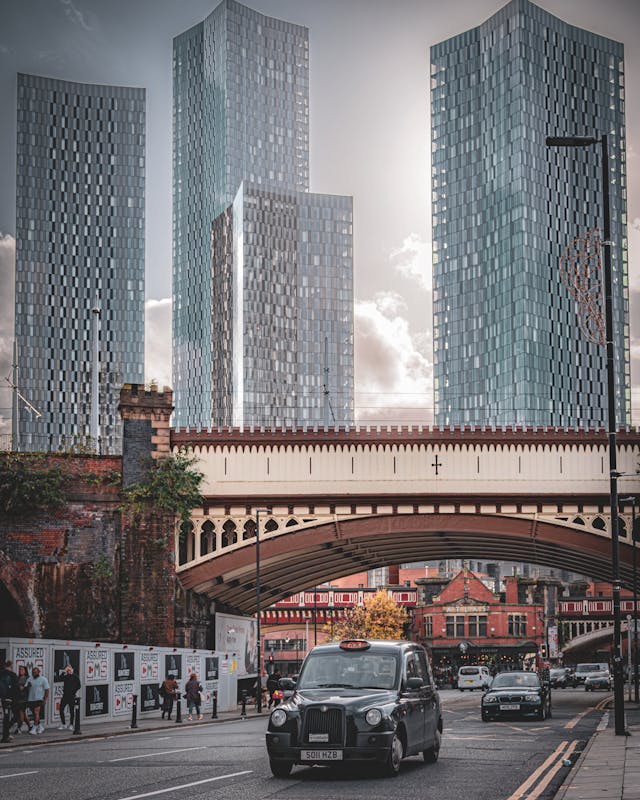

What you will see
Mix of Victorian commercial buildings
Modern glass and steel structures
The Great Northern Warehouse
Beetham Tower (Manchester’s first skyscraper)
John Rylands Library

Historical & cultural significance
One of Manchester’s oldest thoroughfares
Shows the city’s commercial development from Victorian era to present
Demonstrates architectural evolution over two centuries
Represents Manchester’s transformation into a modern city

Look out for…
Height variations from Victorian to contemporary buildings
Contrasting architectural styles
Original Victorian shop fronts
Historic street furniture
Modern architectural interventions
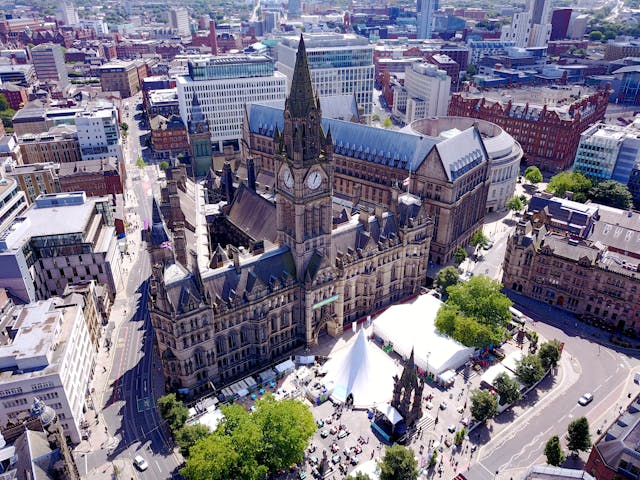
Manchester self-guided walk 1, Stop 5:
Manchester Town Hall Complex

What you will see
Victorian Gothic Town Hall (1877)
Art Deco/Classical Town Hall Extension (1930s)
Circular Central Library building
Modern glass walkways connecting buildings
Contemporary public realm design in St Peter’s Square

Historical & cultural significance
Town Hall built from cotton trade wealth – directly representing industrial success
Forms a unique architectural ensemble showing three centuries of development:
Victorian industrial-era civic pride (Town Hall)
Inter-war modernism (Extension and Library)
Contemporary design (modern renovations and connections)
The £330m current restoration project shows modern construction techniques
Demonstrates continuous evolution of civic architecture from industrial age to present

Look out for…
New public spaces created between buildings
Contrast between Gothic Revival Town Hall and cleaner lines of Extension
Modern glass links between historic buildings
Contemporary public space design in St Peter’s Square
Integration of modern sustainable technologies in restoration
How the complex links different architectural periods while maintaining harmony
Modern tram lines integrated with historic buildings
Manchester self-guided walk 1, Stop 6:
Royal Exchange
For what’s on at the Royal Exchange see website
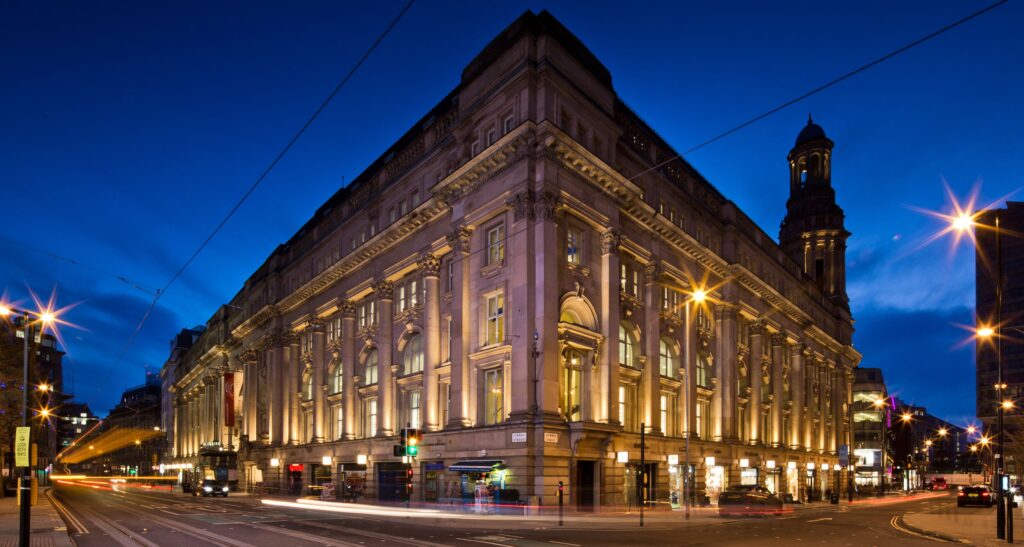

What you will see
Massive trading hall with the largest trading floor in England
Victorian architectural details including grand dome
Modern theatrical “pod” suspended from historic columns
Original trading boards and architectural features
Seven-sided steel and glass theatre module

Historical & cultural significance
Former heart of global cotton trade
World’s largest room for commerce when built
Survived WWII bombing and 1996 IRA bomb
Innovative architectural adaptation preserving heritage
Transformation from commerce to culture represents Manchester’s evolution

Look out for…
Engineering feat of suspended modern theater structure
Original trading boards still visible
Historic marble pillars and glass domed ceiling
Contrast between Victorian architecture and modern theatre pod
Original entrance hall and grand staircases
Floor markers showing former trading positions
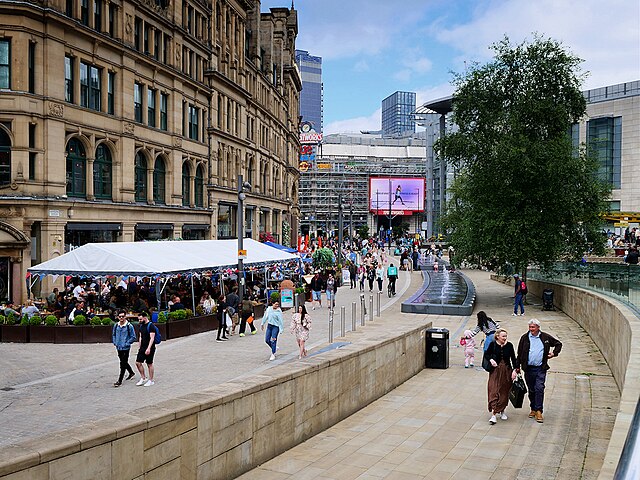
Manchester self-guided walk 1, Stop 7:
Exchange Square

What you will see
Historic Corn Exchange building
Modern shopping developments
The Printworks entertainment complex
Contemporary public space design
Urban regeneration features

Historical & cultural significance
Shows Manchester’s transformation from industrial to commercial centre
Represents post-1996 bomb regeneration
Demonstrates successful mixing of historic and modern architecture
Symbol of Manchester’s economic resilience

Look out for…
Contemporary urban design elements
Original features of the Corn Exchange
Modern interpretations of traditional materials
Public art installations
Integration of transport systems
Manchester self-guided walk 1, Stop 8:
National Football Museum
Entrance fee may be required. See website
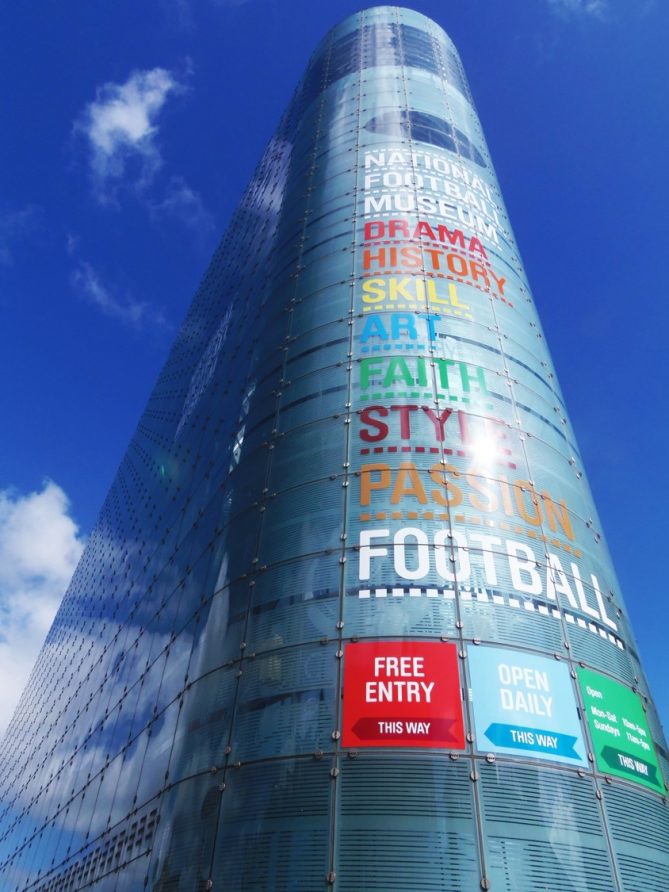

What you will see
Distinctive glass and steel structure
Dramatic angular architecture
Modern exhibition spaces
Interactive displays
City centre views from upper floors

Historical & cultural significance
Represents Manchester’s modern architectural ambitions
Shows the city’s commitment to contemporary design
Houses celebration of football, Manchester’s global cultural export
Symbol of the city’s regeneration and future vision

Look out for…
Views of how the building relates to the city skyline
Innovative use of glass and steel
Relationship with surrounding historic buildings
Sustainable design features
Dynamic internal spaces
